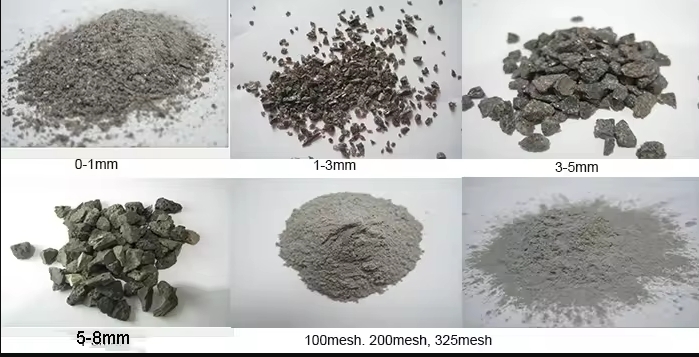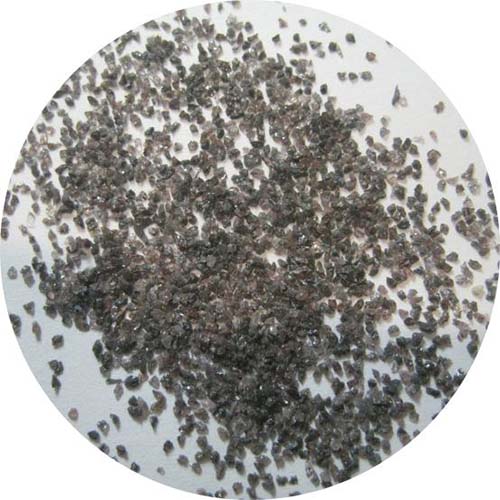Brown Fused Alumina (BFA) is an artifical abrasive and refractory material, mainly composed of aluminum oxide (Al₂O₃), usually containing a small amount of other oxide impurities (such as iron oxide, silicon oxide, etc.). It is made by high-temperature smelting of bauxite (mainly aluminum oxide) and other raw materials, and is named for its brown color.
Main characteristics
1. High hardness: Mohs hardness is 9.0, second only to diamond and silicon carbide, suitable as a grinding material.
2. High melting point: about 2050°C, excellent high temperature resistance.
3. Wear resistance and toughness: not easy to break under high pressure or impact, suitable for heavy-duty grinding.
4. Chemical stability: resistant to acid and alkali corrosion, suitable for complex environments.
Manufacturing process
Brown corundum is usually produced by electric melting:
1. The raw materials (bauxite, coke, iron filings) are melted at high temperature (above 2000°C) in an electric arc furnace.
2. After the melt is cooled, it is crushed and screened to form particles of different sizes.
| SPLIT SIZE | AL2O3 MIN | SIO2 MAX | TIO2 MAX | Fe2O3 MAX |
| 12#-80# | 94.5-96% | 0.6-0.8% | 1.5-3% | 0.12-0.2% |
| 100#-180# | 93.5% | 0.7-1% | 1.5-3.8% | 0.15-0.25% |
| 240#-280# | 92% | 0.85-1.1% | 1.5-3.8% | 0.18-0.35% |
Size Distribution
Grading: FEPA Standard
| Grit size | 3% max., larger than, um | 50% min., in size range, um | 94% min., larger than, um | Grit size | 3% max., larger than, um | 50% min., in size range, um | 94% min., larger than, um |
| F12 | 2000 | N/A | 1400 | F120 | 125 | N/A | 90 |
| F14 | 1700 | N/A | 1180 | F150 | 106 | N/A | 63 |
| F16 | 1400 | N/A | 1000 | F180 | 90 | N/A | 53 |
| F20 | 1180 | N/A | 850 | F220 | 75 | 50.0-56.0 | 45 |
| F24 | 850 | N/A | 600 | F240 | 70 | 42.5-46.5 | 28 |
| F30 | 710 | N/A | 500 | F280 | 59 | 35.0-38.0 | 22 |
| F36 | 600 | N/A | 425 | F320 | 49 | 27.7-30.7 | 16.5 |
| F40 | 500 | N/A | 355 | F360 | 40 | 21.3-24.3 | 12 |
| F46 | 425 | N/A | 300 | F400 | 32 | 16.3-18.3 | 8 |
| F54 | 355 | N/A | 250 | F500 | 25 | 11.8-13.8 | 5 |
| F60 | 300 | N/A | 212 | F600 | 19 | 8.3-10.3 | 3 |
| F70 | 250 | N/A | 180 | F800 | 14 | 5.5-7.5 | 2 |
| F80 | 212 | N/A | 150 | F1000 | 10 | 3.7-5.3 | 1 |
| F90 | 180 | N/A | 125 | F1200 | 7 | 2.5-3.5 | 1 |
| F100 | 150 | N/A | 106 |
Main uses
1. Abrasives: used to make grinding wheels, sandpaper, and sanding belts, suitable for grinding and polishing metals, wood, and glass.
2. Refractory materials: used for high-temperature kiln linings and castables, and can withstand extreme temperatures.
3. Sandblasting: surface cleaning, rust removal, and increased workpiece adhesion.
4. Wear-resistant fillers: enhance the wear resistance of resins or coatings, such as flooring and anti-slip coatings.
5. Ceramic industry: used as an additive to improve the strength of ceramics.
Differences from other corundums
– White corundum: higher purity (Al₂O₃>99%), white color, slightly higher hardness but greater brittleness, suitable for precision machining.
– Black corundum: contains more iron oxide, lower hardness, and is used for low-intensity operations such as stainless steel polishing.
Advantages
– High cost performance: raw materials are easily available, and the production cost is lower than that of white corundum.
– Versatility: It has both hardness and toughness and is widely applicable.
In summary, brown corundum has become an indispensable basic material in industry due to its excellent physical and chemical properties, especially in heavy industry and high energy consumption fields.


